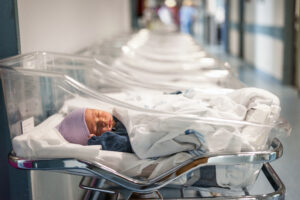Currently, newborns go through the “foot test” to detect nine serious conditions
Share this article
The British government will invest £ 650 million in technology DNA To test all babies born in England. The pioneering plan for sequencing of the genome It seeks to improve the screening and disease prevention in the country.
“The revolution in medical science means that we can transform NHS in the next decade, of a service that diagnoses and treats health problems for one that predicts and prevents them,” said Wes Streeting, the Secretary of Health, to the Telegraph.
Currently, newborns go through the “foot test”In order to detect nine serious conditions, including cystic fibrosis and cardiac conditions. The exam also seeks specifically for problems with eyes, heart, hips and testicles.
“With the power of this new technology, patients will be able to receive personalized health care to prevent health problems before symptoms begin, reducing pressure on NHS services and helping people to live longer and healthier lives,” he added.
Pioneer test
In October last year, NHS (British Health Service) began collection of DNA of 100,000 newborns in 13 Hospitals in England in an attempt to accelerate the diagnosis and treatment of over 200 rare diseases.
The study was conducted in conjunction with the Genomics Englandwhich was responsible for the blood samples collected from the umbilical cords of the babies. Research focused on genetic disorders that develop in early childhood.
The same strategy would be applied to other hospitals in a plan that aims to “revolutionize” the country’s health system. The government also wants to use artificial intelligence -based technologies to provide faster diagnoses.
Read more:
How does the sequencing of a genome works?
- Test offered: Patients with specific medical conditions may receive the offer of a genomic DNA test through the NHS Genomic Medicine Service;
- Sample collected: If they consent, their DNA will be extracted from a sample (blood, fabric or skin) in an NHS laboratory and loaded on a sequencing machine;
- Sequenced sample: The machine determines the sequence of small pieces of DNA, with 150 letters, called “readings”;
- Sequence: The “readings” of the machine are corresponded to a reference sequence. This is called “mapping”;
- Analyzed variants: ‘Variants’ in DNA are analyzed by bioinformatas and reduced to only a few that can be harmful;
- NHS receives list of variants: These few variants are sent back to the NHS laboratory, whose scientists analyze the list of variants and compare them with patient health symptoms and data;
- NHS confirms results: Any findings are communicated to the patient’s doctor. If a variant is confirmed as the cause of a condition, diagnosis and implications are discussed with the patient.
Collaboration for the digital look
Bruna Barone has a degree in Journalism from Cásper Líbero College. She served as editor, reporter and host on BandNews FM radio for 10 years. He is currently collaborating in the digital look.











